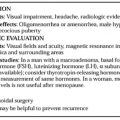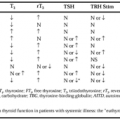ROLE OF PARATHYROID HORMONE RELATED PROTEIN IN PHYSIOLOGY
Unlike PTH, whose expression is highly specific to the parathyroid glands, PTHrP is expressed in many tissues of fetuses and adults. These tissues include cartilage, bone, breast, skin, skeletal, heart and smooth muscle, uterus, and placenta. In addition, several endocrine organs—such as the fetal83,84 and adult parathyroid,85 fetal thyroid,83 and pancreatic islets86 —contain PTHrP transcripts or protein. In the central nervous system, PTHrP is expressed in neurons of the hippocampus, cerebral cortex, and cerebellar cortex.87 Using the polymerase chain reaction, it has been shown that PTHrP expression is even more widespread.88 This, together with the finding that the circulating level of PTHrP is significantly lower than that of PTH, suggests that PTHrP has protean tissue-specific functions, some of which are described here.
CARTILAGE
The best understood action of PTHrP in normal physiology is as a regulator of cartilage growth and differentiation during the process of endochondral bone formation. The abolition of PTHrP gene expression by a targeted mutation of both PTHrP alleles produces embryonic lethality as the result of a severe disorder of cartilage development.89 The limb bones are short, and there is a marked reduction in the width of the zone of proliferation of the growth plate, suggesting that the proliferation of growth plate chondrocytes is grossly impaired. In addition, endochondral bones in the skull base are heavily mineralized at birth, and the cranial vault is misshapen. The ribs are also prematurely mineralized, with a resultant decrease in the circumference of the chest cavity. Thus, the absence of PTHrP is associated with defective proliferation of chondrocytes and accelerated maturation to the hypertrophic stage, in which chondrocytes mineralize their matrix. The converse phenotype is obtained when PTHrP is overexpressed in cartilage from a transgene driven by the cartilage-specific type II collagen promoter:90 chondrocyte maturation is impaired, the growth plate is widened, and immature chondrocytes may be found within trabecular bone.
To carry out its actions in cartilage, PTHrP uses the shared PTH/PTHrP receptor, as evidenced by the similarity of phenotypes when PTHrP and the PTH/PTHrP receptor are ablated in mice37 or in a rare human chondrodysplasia, the Blomstrand type.91,92 Conversely, mutations that constitutively activate the PTH/PTHrP receptor inhibit chondrocyte maturation38 and also induce life-long hypercalcemia, as reported in the human disorder Jansen-type metaphysial chondrodysplasia.39
As predicted from the sharing of a common receptor, PTH has most of the cartilage effects of PTHrP. PTH is a powerful mitogen for proliferating growth plate chondrocytes,93,94 and it inhibits the mineralization of cartilage.95 Yet PTH cannot substitute for the absence of PTHrP in PTHrP knockout mice. The common receptor in avascular cartilage may be relatively inaccessible to circulating PTH, compared with higher levels of PTHrP produced locally, and there may also be fewer PTH/PTHrP receptors in cartilage than in the primary target tissues of PTH, bone, and kidney.
PTHrP functions in endochondral bone formation as part of a feedback loop. Chondrocytes, which have just exited from the proliferative phase and begun to hypertrophy and terminally differentiate, produce the morphogen Indian hedgehog, a member of the hedgehog family of morphogens that regulate many important steps in vertebrate morphogenesis. Via its own receptor in the perichondrial layer surrounding the developing bone, Indian hedgehog signals for the secretion of PTHrP from proliferating chondrocytes, thus up-regulating the proliferation of cartilage cells and keeping them out of the terminal differentiation program.37,96 The effect of the Indian hedgehog-PTHrP system is to relay a signal from mature cells back to the zone of decision. This feedback loop regulates the rate of entry into the differentiation pathway and thereby ensures that proliferation and maturation of chondrocytes is balanced and that cells are synchronized as they enter the last phase of their life, so that the linear growth of bone is orderly. This conclusion is supported by studies of chimeric mice in which clones of PTH/PTHrP receptor (–/–) cells are present in developing cartilage. These cells differentiate prematurely, activate the PTHrP-Indian hedgehog axis, and slow the differentiation of surrounding normal chondrocytes.97
To make available for study PTHrP knockout mice, they have been rescued from lethality by crossing heterozygotes for the PTHrP null genotype with transgenic mice in which expression either of PTHrP98 or of a constitutively active PTH/PTHrP receptor38 has been directed to cartilage. This produces some offspring, which express PTHrP or its constitutively active receptor in cartilage only, thus rescuing them from the fatal chondrodysplasia, while allowing study of the PTHrP null phenotype in other tissues.
Stay updated, free articles. Join our Telegram channel

Full access? Get Clinical Tree





